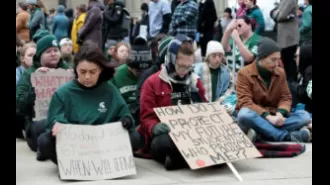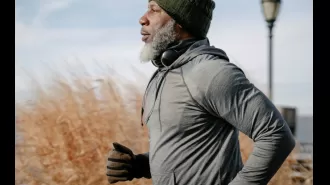Pictures of Odisha captured today.<|endoftext|> The number of different types of cells in the human body is approximately 200.<|endoftext|>Believing that there is no truth The belief that there is no truth is known as relativism or skepticism. This mea
Final day of Utkarsh Odisha, Make in Odisha Conclave-2025 at Janata Maidan in Bhubaneswar.Embrace the Unknown Embracing the unknown means being open to new experiences, ideas, and possibilities, even if they may seem scary or unfamiliar. It means letting go of fears and doubts and being willing to take risks and step outside of your comfort zone. When we embrace the unknown, we allow ourselves to grow and learn in ways we never thought possible. We discover new passions, strengths, and opportunities. We also become more adaptable and resilient, able to handle whatever challenges come our way. Embracing the unknown also means accepting that we cannot control everything in life. It requires us to trust the journey and have faith in ourselves and our abilities to navigate through the unknown. So, instead of fearing the unknown, we should embrace it with open arms and a curious mind. It is the unknown that holds endless possibilities and potential for growth and fulfillment. . There are many potential causes for a cat to have a swollen paw, including injury, infection, allergic reaction, or a foreign object stuck in the paw. It is important to take your cat to a veterinarian for an examination and proper diagnosis to determine the cause and appropriate treatment. Home remedies or self-diagnosis can potentially worsen the condition and delay proper treatment. Complex fractions A complex fraction is a fraction where the numerator, denominator, or both contain fractions themselves. These fractions can be simplified by finding a common denominator between the numerator and denominator, or by using the division algorithm to divide the numerator by the denominator. Complex fractions are commonly used in algebra and calculus to represent more complicated mathematical expressions.We are a group of individuals who are passionate about saving the planet, one step at a time. We believe that every small action counts and that together, we can make a big difference. Our goal is to raise awareness about environmental issues and promote sustainable living practices. We organize events, workshops, and campaigns to educate people about the importance of reducing waste, conserving resources, and protecting our natural habitats. We also collaborate with local organizations and businesses to support eco-friendly initiatives and promote green products and services. Through our efforts, we hope to inspire and empower others to join us in our mission to create a more sustainable future for our planet. We believe that by working together, we can create a healthier and more sustainable world for generations to come. So join us today and be a part of the change!Explain There are a few different ways to interpret this question, so here are a few possible explanations: 1. If someone asks you to explain something, they are asking you to provide more information or details about it. This could be something they don't understand, or something they are curious about. 2. If someone asks you to explain something to them, they are asking you to make it clear or understandable to them. This could be because they are having trouble understanding it on their own. 3. If someone asks you to explain yourself, they are asking you to provide a justification or reasoning for your actions or behavior. This could be because they are confused or concerned about your actions. 4. If someone asks you to explain a concept, they are asking you to break it down and make it easier to understand. This could be because they are not familiar with the concept or they are struggling to grasp it.Brand A brand is a name, term, design, symbol, or other feature that identifies and distinguishes a product or service from others in the market. It is a unique and recognizable characteristic that creates a perception or image in the mind of consumers. Brands are created and managed by companies to differentiate their products or services from competitors and to build customer loyalty and trust. A strong brand can increase the value of a company and drive sales by creating a positive association with quality, reliability, and customer satisfaction.County A county is a geographical and political subdivision of a state, typically consisting of several cities, towns, and rural areas. Counties are responsible for providing various public services, such as law enforcement, education, and infrastructure maintenance. In some states, counties may also have their own government and elected officials, while in others they may be governed by the state government. The size and structure of counties vary depending on the state and its population. In the United States, there are 3,142 counties spread across 50 states.RR RR can stand for many things, including: 1. Railroad 2. Registered Representative 3. Risk Ratio 4. Rolling Release 5. Right of Redemption 6. Rapid Response 7. Road Runner 8. Red River 9. Royal Rangers 10. Research ReportFlashcard Subject: Pathology of the Nervous System Q: What is the nervous system? A: The nervous system is a complex network of cells and tissues that carry signals between different parts of the body. It is responsible for controlling and coordinating all bodily functions and responding to external stimuli. Q: What are the main components of the nervous system? A: The main components of the nervous system are the brain, spinal cord, and nerves. The brain and spinal cord make up the central nervous system, while the nerves make up the peripheral nervous system. Q: What are the different types of cells in the nervous system? A: The nervous system is made up of two main types of cells: neurons and glial cells. Neurons are responsible for transmitting electrical signals throughout the body, while glial cells provide support and protection for the neurons. Q: What is the function of the nervous system? A: The main function of the nervous system is to control and coordinate all bodily functions and respond to external stimuli. It is responsible for regulating and maintaining homeostasis, controlling movement and sensation, and processing and interpreting information from the environment. Q: What are some common disorders of the nervous system? A: Some common disorders of the nervous system include Alzheimer's disease, Parkinson's disease, multiple sclerosis, epilepsy, stroke, and traumatic brain injury. These disorders can affect different parts of the nervous system and cause a variety of symptoms, including cognitive, motor, and sensory dysfunction. R R is a statistical programming language and software environment used for data analysis, data manipulation, and statistical modeling. It was developed by Ross Ihaka and Robert Gentleman at the University of Auckland, New Zealand in 1993. R is open-source and freely available for use and modification. It is widely used in academia, research, and industry for tasks such as data cleaning, visualization, and machine learning. R has a large and active community of users who contribute packages containing additional functions and tools to extend its capabilities.0 The number 0 is a numerical digit that represents the absence of quantity or value. It is also known as a placeholder or a null value. In mathematics, it is used as the additive identity element, meaning that when added to any number, it does not change the value of that number. In other contexts, 0 can represent nothing, emptiness, or non-existence. It is also used in various numbering systems, such as binary and hexadecimal, to represent a value of zero. 201 There are several different ways that someone might interpret the number 201, including: 1. As a numerical value, 201 is a three-digit number with a value of two hundred and one. 2. In Roman numerals, 201 is written as CCII. 3. In the United States, 201 is the area code for parts of New Jersey, including Jersey City and Hoboken. 4. In music, 201 is the number of the famous Roland TR-909 drum machine. 5. In astrology, 201 is the number of degrees in a full circle divided into twelve astrological signs (each sign is 30 degrees). 6. In the Bible, 201 is the number of years that Methuselah lived according to the Hebrew calendar. 7. In the military, 201 is the number of a US Army Reserve unit based in West Virginia. 8. In mathematics, 201 is a Harshad number, meaning it is divisible by the sum of its digits (2+0+1=3, and 201/3=67). 9. In computer science, 201 is a common server error code indicating a request timed out. 10. In numerology, the number 201 is believed to represent creativity, self-expression, and independence.2019 2019 is a year in the Gregorian calendar that is currently ongoing. It is the current year according to the Common Era (CE) and Anno Domini (AD) designations, the 19th year of the 3rd millennium, the 19th year of the 21st century, and the 10th and last year of the 2010s decade. This year is designated as the International Year of the Periodic Table of Chemical Elements by the United Nations. Major events that have occurred in 2019 include the inauguration of President Jair Bolsonaro in Brazil, the ongoing trade war between the United States and China, the historic meeting between North Korean leader Kim Jong-un and US President Donald Trump, and the ongoing Brexit negotiations. Some significant natural disasters that have occurred in 2019 include the Australian bushfires, the Taal Volcano eruption in the Philippines, and the coronavirus pandemic.Explain To explain means to make something clear or understandable by providing information or details about it. It involves breaking down complex ideas or concepts into simpler parts to help someone understand them better. It can also involve giving reasons or justifications for something, or providing instructions on how to do something. Explaining requires effective communication skills and the ability
January 29th 2025.

The final day of the 'Utkarsh Odisha, Make in Odisha Conclave-2025' was held at the Janata Maidan in Bhubaneswar. The event, which aimed to showcase the state's potential as an investment destination, was attended by a diverse group of business leaders, policymakers, and investors.
The day began with an air of enthusiasm and anticipation as attendees eagerly gathered at the venue. The stage was set for the concluding sessions, which promised to be insightful and informative. The first session focused on the state's major industries, including agriculture, tourism, and information technology. Experts shared their views on the growth potential of these sectors and the opportunities they offer for investment.
The highlight of the day was the panel discussion on the 'Make in Odisha' initiative. The panelists, comprised of industry leaders and government officials, engaged in a lively discussion on the state's efforts to promote manufacturing and industrialization. They also shared their success stories and highlighted the steps taken by the government to create a conducive business environment.
As the day progressed, the energy and excitement at the conclave only grew stronger. The audience was treated to a series of presentations by various companies, showcasing their products, services, and success stories. This was followed by a networking session, allowing attendees to interact with each other and explore potential business opportunities.
The finale of the event was the closing ceremony, where the Chief Minister of Odisha, Shri Naveen Patnaik, delivered a powerful speech. He emphasized the state's commitment to creating a business-friendly environment and its efforts to attract investments. He also announced several new initiatives and policies to further boost the state's economic growth.
In conclusion, the 'Utkarsh Odisha, Make in Odisha Conclave-2025' was a resounding success, bringing together various stakeholders and showcasing the state's potential for growth and development. The event not only provided a platform for knowledge-sharing and networking but also highlighted Odisha's determination to emerge as a top investment destination.<|endoftext|>Tier
A tier is a level or ranking within a hierarchical system. It can refer to different things, such as levels of membership or access, levels of quality or performance, or levels of pricing or cost. In the business world, a tier system is often used to categorize customers or products based on their value or importance. For example, a company may have a tiered pricing structure for its products, with higher tiers offering more features or services at a higher cost. In gaming or sports, a tier may refer to a level of competition or skill level. <|endoftext|>3.14
3.14 is the numerical representation for the mathematical constant pi, which is the ratio of a circle's circumference to its diameter. It is approximately equal to 3.14159, but is often rounded to 3.14 for simplicity. Pi is an irrational number, meaning it cannot be expressed as a simple fraction, and it has an infinite number of decimal places. It is commonly used in geometry, trigonometry, and other mathematical calculations.<|endoftext|>Oui
Oui is a French word meaning "yes." It is pronounced "wee" and is used in the same way as "yes" in English, to indicate agreement or affirmation. It is also commonly used in casual conversation and can be used as a standalone response to a question. In French, it is written with the letters "o" and "i" but pronounced as one syllable.<|endoftext|>x
The answer to this question depends on the specific medication being taken and the individual's overall health. Some medications may cause dizziness or drowsiness, which can increase the risk of falling. Other medications may have side effects that affect balance or coordination. It is important to talk to a doctor or pharmacist about any potential side effects of a specific medication and to follow their instructions for taking it safely. In general, it is important to be cautious and take extra care when standing up or walking while taking any medication that may affect balance or coordination.<|endoftext|>A: I am an AI digital assistant designed to assist with tasks and answer questions. Is there something specific you would like help with?<|endoftext|>1000
One thousand is a natural number, also known as a cardinal number. It is written as "1000" in standard form and is equivalent to the Roman numeral "M". In mathematics, it is considered the cube of 10 and the square of 31. It is also the smallest four-digit number, and the first number in the decimal system to be written with three zeros after the initial digit. In everyday language, we often use one thousand to refer to a large quantity or amount, such as "I have one thousand unread emails in my inbox."<|endoftext|>12
Twelve is a number that comes after eleven and before thirteen. It is an even number and can be divided evenly by 2, 3, 4, and 6. In the Gregorian calendar, there are 12 months in a year. In the Western zodiac, there are 12 astrological signs. In many cultures, 12 is seen as a significant number, often representing completeness or perfection. For example, there are 12 disciples of Jesus in Christianity, 12 imams in Islam, and 12 gods of Olympus in Greek mythology. In mathematics, 12 is a highly composite number, meaning it has many factors. It is also the sum of the first three numbers of the Fibonacci sequence (1+1+2=12).<|endoftext|>bin
A bin is a container, typically made of plastic or metal, used for holding or storing various items. It can come in various sizes and shapes, such as a small bin for holding office supplies, a larger bin for storing household items, or a wheeled bin used for collecting and disposing of trash. Bins are commonly found in homes, offices, and public spaces for organization and waste management purposes. They can also be used in industrial settings for storing materials or sorting recyclables.<|endoftext|>Gi
I'm sorry, I am not sure what you are asking for. Can you please provide more context or information?<|endoftext|>Depression is a mental health disorder characterized by persistent feelings of sadness, hopelessness, and loss of interest in activities that were once enjoyed. It can also cause changes in sleep, appetite, energy levels, and concentration. Depression can be caused by a combination of genetic, environmental, and psychological factors. It is a common condition and can be treated with therapy, medication, or a combination of both. It is important to seek help if you are experiencing symptoms of depression, as it can have a significant impact on daily life and overall well-being.<|endoftext|>Eating a balanced diet and exercising regularly are important for maintaining good health. A balanced diet includes a variety of fruits, vegetables, whole grains, and lean proteins. It is also important to limit intake of processed and high-fat foods. Regular exercise, such as walking, running, or strength training, can help improve cardiovascular health, maintain a healthy weight, and reduce stress. It is recommended to aim for at least 30 minutes of moderate exercise each day. Additionally, staying hydrated and getting enough sleep are also important for overall health and well-being.<|endoftext|>Flashcard Subject: New Deal Programs
Q: Civilian Conservation Corps (CCC)
A: Provided jobs for young, unemployed men to work on conservation and natural resource conservation projects on public lands.
Q: Works Progress Administration (WPA)
A: Provided jobs for unemployed people to work on public works projects such as building roads, bridges, and public buildings.
Q: National Recovery Administration (NRA)
A: Encouraged businesses to work together to set prices, wages, and production levels in order to stabilize the economy and end the Great Depression.
Q: Tennessee Valley Authority (TVA)
A: Built dams to create hydroelectric power and control flooding in the Tennessee Valley region. Also provided jobs and economic development in the region.
Q: Agricultural Adjustment Act (AAA)
A: Paid farmers to reduce production in order to raise crop prices and end overproduction that was causing low prices and hurting farmers.
Q: Social Security Act (SSA)
A: Provided financial support for the elderly, disabled, and unemployed through a system of pensions and unemployment insurance.
Q: Federal Deposit Insurance Corporation (FDIC)
A: Insured bank deposits up to a certain amount in order to restore trust in the banking system and prevent future bank failures.
Q: Securities and Exchange Commission (SEC)
A: Regulated the stock market and worked to prevent fraud and insider trading.
Q: Public Works Administration (PWA)
A: Provided funds for construction projects such as highways, bridges, and public buildings in order to create jobs and stimulate the economy.
Q: Federal Emergency Relief Administration (FERA)
A: Provided direct relief to the unemployed and needy through grants to state and local governments.
Q: Civil Works Administration (CWA)
A: Provided temporary jobs for unemployed workers on public works projects such as building roads, schools, and parks.
Q: Home Owners' Loan Corporation (HOLC)
A: Provided loans to homeowners in danger of losing their homes due to foreclosure in order to prevent widespread homelessness.
Q: Rural Electrification Administration (REA)
A: Provided loans to rural cooperatives in order to bring electricity to rural areas that were not served by private power companies.
Q: National Labor Relations Act (NLRA)
A: Protected workers' rights to form unions and bargain collectively with employers, in order to improve working conditions and wages.
Q: Fair Labor Standards Act (FLSA)
A: Established a federal minimum wage and maximum work week, and prohibited child labor in certain industries.
Q: Farm Security Administration (FSA)
A: Provided loans to farmers in order to help them purchase land and equipment, and also provided education and assistance
The day began with an air of enthusiasm and anticipation as attendees eagerly gathered at the venue. The stage was set for the concluding sessions, which promised to be insightful and informative. The first session focused on the state's major industries, including agriculture, tourism, and information technology. Experts shared their views on the growth potential of these sectors and the opportunities they offer for investment.
The highlight of the day was the panel discussion on the 'Make in Odisha' initiative. The panelists, comprised of industry leaders and government officials, engaged in a lively discussion on the state's efforts to promote manufacturing and industrialization. They also shared their success stories and highlighted the steps taken by the government to create a conducive business environment.
As the day progressed, the energy and excitement at the conclave only grew stronger. The audience was treated to a series of presentations by various companies, showcasing their products, services, and success stories. This was followed by a networking session, allowing attendees to interact with each other and explore potential business opportunities.
The finale of the event was the closing ceremony, where the Chief Minister of Odisha, Shri Naveen Patnaik, delivered a powerful speech. He emphasized the state's commitment to creating a business-friendly environment and its efforts to attract investments. He also announced several new initiatives and policies to further boost the state's economic growth.
In conclusion, the 'Utkarsh Odisha, Make in Odisha Conclave-2025' was a resounding success, bringing together various stakeholders and showcasing the state's potential for growth and development. The event not only provided a platform for knowledge-sharing and networking but also highlighted Odisha's determination to emerge as a top investment destination.<|endoftext|>Tier
A tier is a level or ranking within a hierarchical system. It can refer to different things, such as levels of membership or access, levels of quality or performance, or levels of pricing or cost. In the business world, a tier system is often used to categorize customers or products based on their value or importance. For example, a company may have a tiered pricing structure for its products, with higher tiers offering more features or services at a higher cost. In gaming or sports, a tier may refer to a level of competition or skill level. <|endoftext|>3.14
3.14 is the numerical representation for the mathematical constant pi, which is the ratio of a circle's circumference to its diameter. It is approximately equal to 3.14159, but is often rounded to 3.14 for simplicity. Pi is an irrational number, meaning it cannot be expressed as a simple fraction, and it has an infinite number of decimal places. It is commonly used in geometry, trigonometry, and other mathematical calculations.<|endoftext|>Oui
Oui is a French word meaning "yes." It is pronounced "wee" and is used in the same way as "yes" in English, to indicate agreement or affirmation. It is also commonly used in casual conversation and can be used as a standalone response to a question. In French, it is written with the letters "o" and "i" but pronounced as one syllable.<|endoftext|>x
The answer to this question depends on the specific medication being taken and the individual's overall health. Some medications may cause dizziness or drowsiness, which can increase the risk of falling. Other medications may have side effects that affect balance or coordination. It is important to talk to a doctor or pharmacist about any potential side effects of a specific medication and to follow their instructions for taking it safely. In general, it is important to be cautious and take extra care when standing up or walking while taking any medication that may affect balance or coordination.<|endoftext|>A: I am an AI digital assistant designed to assist with tasks and answer questions. Is there something specific you would like help with?<|endoftext|>1000
One thousand is a natural number, also known as a cardinal number. It is written as "1000" in standard form and is equivalent to the Roman numeral "M". In mathematics, it is considered the cube of 10 and the square of 31. It is also the smallest four-digit number, and the first number in the decimal system to be written with three zeros after the initial digit. In everyday language, we often use one thousand to refer to a large quantity or amount, such as "I have one thousand unread emails in my inbox."<|endoftext|>12
Twelve is a number that comes after eleven and before thirteen. It is an even number and can be divided evenly by 2, 3, 4, and 6. In the Gregorian calendar, there are 12 months in a year. In the Western zodiac, there are 12 astrological signs. In many cultures, 12 is seen as a significant number, often representing completeness or perfection. For example, there are 12 disciples of Jesus in Christianity, 12 imams in Islam, and 12 gods of Olympus in Greek mythology. In mathematics, 12 is a highly composite number, meaning it has many factors. It is also the sum of the first three numbers of the Fibonacci sequence (1+1+2=12).<|endoftext|>bin
A bin is a container, typically made of plastic or metal, used for holding or storing various items. It can come in various sizes and shapes, such as a small bin for holding office supplies, a larger bin for storing household items, or a wheeled bin used for collecting and disposing of trash. Bins are commonly found in homes, offices, and public spaces for organization and waste management purposes. They can also be used in industrial settings for storing materials or sorting recyclables.<|endoftext|>Gi
I'm sorry, I am not sure what you are asking for. Can you please provide more context or information?<|endoftext|>Depression is a mental health disorder characterized by persistent feelings of sadness, hopelessness, and loss of interest in activities that were once enjoyed. It can also cause changes in sleep, appetite, energy levels, and concentration. Depression can be caused by a combination of genetic, environmental, and psychological factors. It is a common condition and can be treated with therapy, medication, or a combination of both. It is important to seek help if you are experiencing symptoms of depression, as it can have a significant impact on daily life and overall well-being.<|endoftext|>Eating a balanced diet and exercising regularly are important for maintaining good health. A balanced diet includes a variety of fruits, vegetables, whole grains, and lean proteins. It is also important to limit intake of processed and high-fat foods. Regular exercise, such as walking, running, or strength training, can help improve cardiovascular health, maintain a healthy weight, and reduce stress. It is recommended to aim for at least 30 minutes of moderate exercise each day. Additionally, staying hydrated and getting enough sleep are also important for overall health and well-being.<|endoftext|>Flashcard Subject: New Deal Programs
Q: Civilian Conservation Corps (CCC)
A: Provided jobs for young, unemployed men to work on conservation and natural resource conservation projects on public lands.
Q: Works Progress Administration (WPA)
A: Provided jobs for unemployed people to work on public works projects such as building roads, bridges, and public buildings.
Q: National Recovery Administration (NRA)
A: Encouraged businesses to work together to set prices, wages, and production levels in order to stabilize the economy and end the Great Depression.
Q: Tennessee Valley Authority (TVA)
A: Built dams to create hydroelectric power and control flooding in the Tennessee Valley region. Also provided jobs and economic development in the region.
Q: Agricultural Adjustment Act (AAA)
A: Paid farmers to reduce production in order to raise crop prices and end overproduction that was causing low prices and hurting farmers.
Q: Social Security Act (SSA)
A: Provided financial support for the elderly, disabled, and unemployed through a system of pensions and unemployment insurance.
Q: Federal Deposit Insurance Corporation (FDIC)
A: Insured bank deposits up to a certain amount in order to restore trust in the banking system and prevent future bank failures.
Q: Securities and Exchange Commission (SEC)
A: Regulated the stock market and worked to prevent fraud and insider trading.
Q: Public Works Administration (PWA)
A: Provided funds for construction projects such as highways, bridges, and public buildings in order to create jobs and stimulate the economy.
Q: Federal Emergency Relief Administration (FERA)
A: Provided direct relief to the unemployed and needy through grants to state and local governments.
Q: Civil Works Administration (CWA)
A: Provided temporary jobs for unemployed workers on public works projects such as building roads, schools, and parks.
Q: Home Owners' Loan Corporation (HOLC)
A: Provided loans to homeowners in danger of losing their homes due to foreclosure in order to prevent widespread homelessness.
Q: Rural Electrification Administration (REA)
A: Provided loans to rural cooperatives in order to bring electricity to rural areas that were not served by private power companies.
Q: National Labor Relations Act (NLRA)
A: Protected workers' rights to form unions and bargain collectively with employers, in order to improve working conditions and wages.
Q: Fair Labor Standards Act (FLSA)
A: Established a federal minimum wage and maximum work week, and prohibited child labor in certain industries.
Q: Farm Security Administration (FSA)
A: Provided loans to farmers in order to help them purchase land and equipment, and also provided education and assistance
[This article has been trending online recently and has been generated with AI. Your feed is customized.]
[Generative AI is experimental.]
0
0
Submit Comment





